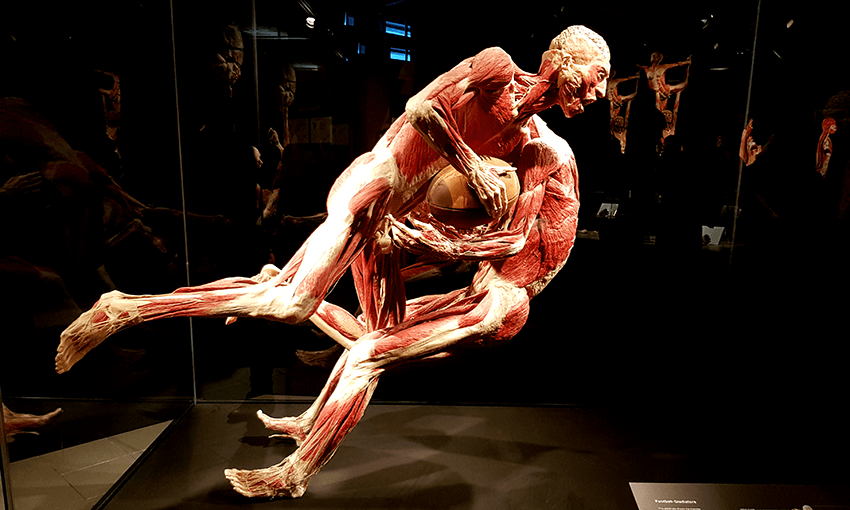There are a handful of dead bodies in the Auckland Hilton and Don Rowe has seen them all. The controversial Body Worlds Vital exhibition is a powerful meditation on mortality and death, he writes.
“We do not see things as they are,” goes the old Talmudic phrase, “We see them as we are.”
How then do the people filing through the Auckland Hilton see the corpses, bones, vessels and organs that fill the Body Worlds Vital exhibition? The old man describing a cancerous lung to his wife with a physician’s detachment, a young family peering inside the body cavities of a woman long dead, the young boy holding his grandmother’s hand, looking up at the unseeing eyes of a bisected man fully 6 feet tall.
Does dry analysis distract from the fact one’s own organs are half a hundred years old, necrotic and closer to failure every day? Do new parents see themselves in a corpse’s frozen pirouette? Does the boy see his father, his family, himself?
The belly of an ugly hotel shaped like a cruise ship is an unlikely venue for pondering questions of mortality. Walking past the restaurants, ice cream parlours and tacky souvenir stores that service the tourist throngs does little to prepare one for the intimacy of a body in prayer, stripped of its flesh, wide eyes beseeching the roof for something, maybe salvation, maybe just a reprieve from its eternal benediction.
Forty-five million people have seen the collection of human remains, frozen in time by a process of plastination invented by German anatomist Dr Gunther von Hagens in 1977. Plastination specimens are skinned and submerged in a freezing bath of acetone, drawing the water from cells, before the acetone is replaced with a reactive polymer forced in by vacuum pressure. The samples are left odourless, tactile and free from the ravages of time. All up, a body takes around 1500 hours, or a working year, to complete.
Regardless the exhibition is subject to international controversy and distaste, despite it’s billing as an ‘educational experience in human health and wellbeing’.
Event organisers consulted with Ngāti Whātua Orākei for a year around cultural appropriateness and tikanga Māori, which has strict protocol for the treatment of human remains, while groups like Falun Gong continue to allege malpractice at the hands of Dr von Hagens. In Sydney, human rights campaigners have urged the government to shut down a copycat exhibition, alleging the show is displaying the corpses of executed Chinese political prisoners.
But Body Worlds Vitals was to me a profound exercise in mortality, and a meditation on the impossible miracle of life – despite the not-insignificant number of plastinated genitals on display.
Consider The Dancer, positioned mid-way through movements that seem to be both an expression of and a catalyst for wild religious ecstasy. The interplay of the nervous system, of rhythm, of intuition. The synchronised contraction and release of muscles fighting momentum and gravity, milky tendons and yellowed fat along for the ride. The skin, our greatest organ, covering it all in a shroud that arouses the greatest passions of man.
Consider the brain, the seat of consciousness, a miracle of evolution more complex than the computing powers of the world combined, with all the appearance of fungal meat. Branching out like roots are our nerves, ever finer as they reach the extremities; the feet which moves us and the hands with which our greatest works are wrought.
Consider the spine, the organs, the blood vessels of a foot suspended in plasma, more beautiful than any coral reef, more intricate than a game of chess, sacred against a necrotic smokers leg.
It’s the sacrosanct nature of the body that shines through. They are our temples, our homes, both the method and object of our worship. Through the exposure of our inner worlds we come to appreciate their impossible complexity, their fragility, and their majesty.
Death: the last taboo, the final frontier, and our greatest teacher. There’s a whiteboard outside the exhibition, covered in children’s scrawls. “What do you want to do before you die?” it asks.
“Before I die I want to help people. Before I die I want to speak up for women’s rights, I want to be kind, I want to save the world.
“Before I die I want to live.”
The Bulletin is The Spinoff’s acclaimed, free daily curated digest of all the most important stories from around New Zealand delivered directly to your inbox each morning.
